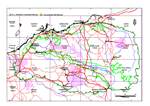Click on images
to enlarge



Photographer: B.R. Maslin

Photographer: B.R. Maslin

Photographer: B.R. Maslin

Photographer: J. Maslin

Photographer: B.R. Maslin
, BRM 8677, lab photo by Fiona McCallum ADJUSTED_sml.jpg)
Seed from one herbarium voucher. Scale in mm. Photographer: F. McCallum.
Botanical name
Acacia arrecta Maslin, Nuytsia 4: 73, figs 2 & 10 (1982)
Common name
Yarnda Nyirra Wattle (preferred common name) or Fortescue Wattle
Description
Low, compact, spreading, generally glabrous shrubs 0.5-1 (-1.5) m tall and up to 2 m across, multi-stemmed or sparingly branched at ground level, rounded or flat-topped. Bark grey, smooth except slightly fissured at extreme base of main stems. Branchlets resin-ribbed at their apices. Phyllodes ±terete, (15-) 20-40 mm long, about 1 mm in diameter, curved upwards from near the base giving the foliage a characteristic erect aspect, greyish green, resinous (but not sticky) especially over nerves; very obscurely 8-nerved; narrowed at apex into a hard, acute, non-spiny point. Inflorescences simple; peduncles 15-40 mm long, somewhat thick, erect; heads prolific, globular, 10-12 mm in diameter when fresh, quite resinous, light golden, 30-45-flowered. Flowers 5-merous; calyx shortly divided into broadly triangular lobes. Pods sub-terete to compressed, broadest at top and tapered towards the base, 4.5-5 cm long, 4-6 mm wide, held erect, woody, opening elastically from apex with the valves becoming recurved following dehiscence, straight, glossy resinous (but not sticky) when young, longitudinally veined, yellowish brown to dark brown; the margins not thickened. Seeds ±oblique in pods and seated in distinct, pronounced chambers, ellipsoid, 3-4 mm long, not readily shed following pod dehiscence, rather dull, blackish except pleurogram bordered by pale-coloured tissue; the funicle-aril pale coloured, straight and narrowly conical.
Characteristic features
Low, spreading shrubs. Phyllodes short (mostly 20-40 mm long), terete, curved upwards from the base. Heads quite large (10-12 mm in diameter when fresh) and held on erect peduncles that are 15-40 mm long. Pods held erect, woody, ±terete, broadest at top and tapered to base, longitudinally nerved. Funicle-aril straight and narrowly conical.
Distribution and ecology
Confined to the Pilbara region of northwest Western Australia where it has a scattered distribution from near Millstream east to near Nullagine and south to the northern part of the Hamersley Range around Wittenoom. Acacia arrecta is often common in the places where it occurs. It favours low, rocky hills and associated stony flats in shrub -steppe dominated by spinifex.
Flowering and fruiting period
Because of the paucity of collections it is difficult to accurately assess the flowering and fruiting phenology of this species. It appears that flowering at least is dependent upon the timing and intensity of rainfall events. Specimens in flower have been collected from March to June with most in March and April (presumably in response to summer cyclones). During the main flowering flush the plants are very attractive on account of the profusion of large heads. Pods with mature seeds have been collected in September and October. Plants are commonly seen with both flowers (in bud and at anthesis) and developing pods at the same time.
Affinities
Related to A. hilliana which has a similar growth form and phyllodes, and which sometimes grows with A. arrecta but is readily distinguished by having flowers arranged in cylindrical spikes and pods with thickened marginal nerves. When sterile A. arrecta can easily be confused with A. hilliana , especially to the untrained observer. Probably also related to A. arida and A. orthocarpa but these two species are normally taller shrubs, have flowers that are arranged in cylindrical spikes and phyllodes which are invested with numerous, minute dots (observe at x10 magnification or higher).
Notes
This is an attractive species when in full flower and has horticultural potential as a ground cover or for rockeries.
Conservation status
Not considered rare or endangered.
Origin of name
The botanical name is derived from the Latin arrectus (upright) in allusion to the characteristically erect phyllodes, peduncles and pods. The common name Yarnda Nyirra Wattle is from the Yindjibarndi peoples name for the Fortescue River and thus reflects the distribution of A. arrecta which is almost entirely restricted to the Fortescue sub- region of the Pilbara. The Yindjibarndi people are the traditional owners of the lands in the west Pilbara around Millstream on the Fortescue River.
